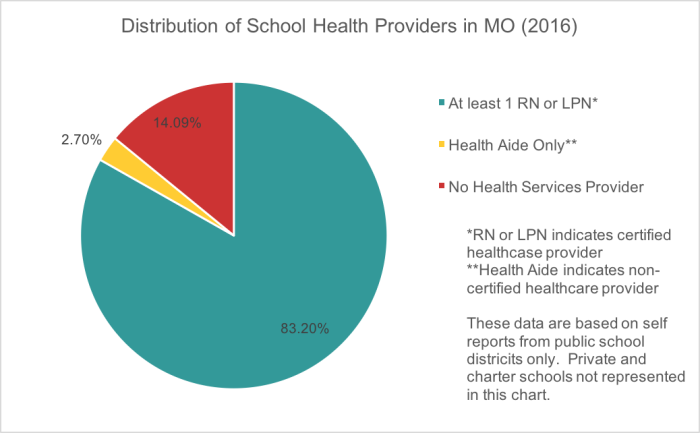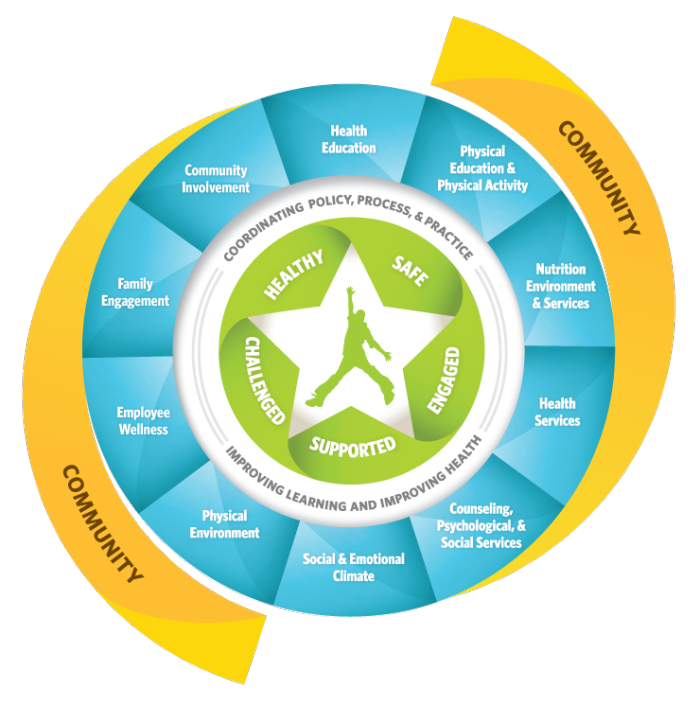School Nurses and the State School Nurse Consultant: A Continued Commitment to Children’s Health
Over the last few months, Missouri KIDS COUNT has featured a series of articles on school nurses. In the first article, we focused on the roles and responsibilities of school nurses and health aides in Missouri. In the second article, we showcased the important data collected in schools, described the impact of many of the complex health conditions and medical procedures addressed by school nurses and shared inspiring stories from school nurses. In the third article, we described the impact of socioeconomic factors on child health and the efforts of school nurses to foster meaningful community connections to support school children and their families.
In this final piece, we begin by providing a brief historical overview about the critical partner in the success of school nurses in Missouri—Marge Cole, the State School Nurse Consultant. We share the most current data on the distribution of school nurses across public schools in Missouri. We conclude with a Call to Action describing how you can support the work of school nurses and their efforts to keep our children healthy and ready to learn.
THE STATE’S COMMITMENT TO SCHOOL NURSES
In 2013, 36 states had a State School Nurse Consultant (SSNC), hired by the Department of Education or the Department of Health. The responsibilities of the SSNC include to “provide national leadership and advocacy to promote the health and learning of children, envision and proactively influence the future of school health and school nursing practice, advocate for quality school nursing services, provide a support network and share information among individual state school nurse consultants, and impact public policy related to children’s health and education issues through collaborative endeavors with other associations and agencies”. i
The Missouri KIDS COUNT team interviewed current SSNC Marjorie (Marge) Cole to understand the history of school health services in Missouri and the state’s continued commitment to school nurses. Marge became the Department of Health State School Nurse Consultant in 2001, after working as a nurse in various clinical settings, and as a school nurse in St. Louis County Special School District during the 1980s. At that time, school nursing in Missouri was in its infancy, with few protocols or guidelines for school nurses. Nurses were simply learning from each other.
The Missouri Department of Health (DOH) hired the first State School Nurse Consultant, Nela Beetem, in the late 1980s to provide professional development for school health services and develop guidelines for school nurses. Nela directed the first school health staffing assessment which revealed that half of Missouri school districts did not have a school nurse and that there was no dedicated funding for school nurses at the state level. Her efforts to increase the presence of school nurses across Missouri school districts eventually led to the development of the Missouri School-Age Children’s Health Services (SHS) Program established through House Bill 564.
HB564, passed in 1994, enabled DOH and the MO Department of Social Services (DSS), in collaboration with the Department of Elementary and Secondary Education (DESE), to provide funding to local public schools and local public health agencies for population-based health services for all school-age children in their local jurisdiction. Prior to HB564, approximately 268 public school districts were without routine health services. By 2010, 518 of the 524 public school districts had a formal school health program and only six did not.
The goals of the SHS program were to increase access to primary and preventive health care; increase utilization of Medicaid to address the school-related needs of children with special health care concerns; and improve the health and safety of all children in schools. The SHS Program helped many school districts establish local advisory councils that make recommendations for changes based on current data and create important partnerships between school nurses and community members. Additionally, this program helped develop local infrastructure and capacity so that school health services became stronger and more ingrained in communities as a whole.
Marge uses her position to help nurses think beyond raw numbers and tasks. For example, if a nurse reported doing 500 vision screenings, Marge urges that nurse to follow up and ask the tough questions such as: ‘how many children failed those screenings?’ and ‘of the children who failed the screening, how many were you able to create a care plan for?’. Changing the narrative in this way allows school health services to become more comprehensive and helps create a culture of thinking beyond quotas and siloed tasks. Nurses were also required to attend regional professional development meetings as part of the SHS Program, which allowed them to share experiences and strategies with those from like communities around the state.
The SHS Program led to several other important accomplishments, and has enabled more Missouri children to access preventative health services and manage health conditions at school and in their communities.
Program Accomplishments ii
• Children in SHS program with access to a regular source of medical care increased from 33% to 87%
• Children in the SHS program with a dental exam within the past 12 months increased from 16% to 55%
• Children in the SHS program with Chronic Conditions/Special Healthcare Needs maintaining or improving healthcare outcomes through care coordination reached 94%
• Children in the SHS program with persistent asthma, maintaining control of persistent asthma through care coordination with school nurse reached 93%
• Children with referral completion for hearing screening increased from 42% to 83%
• Children with referral completion for vision screening deficits increased from 39% to
84%
• 102 school districts have successfully transitioned from the program and maintained
services
• Public schools with a formal school health program increased from 50% to 99%
In the 15 years that Marge has been carrying out her work with school health services programs, she describes her proudest accomplishments as increasing access to care, the formation of school health advisory councils, and collection of critical data, which all improved and increased children’s readiness to learn.
Marge’s work, as well as the efforts the Missouri Department of Health and Senior Services (MO DHSS) has committed to, have helped school nurses throughout the state recognize their power as change-makers in the lives of children and families.
CHALLENGES AND BARRIERS
In June 2010, funding for the SHS Program was suspended. The immediate impact was 41 school districts with no health services and 82 school districts with a reduction in staffing. The SHS program continues to provide technical assistance and consultation to all schools by way of email blasts, telephone consultations, webinars, and listserv postings.
Despite these cuts, Missouri remains in the top five states with best nurse to student ratios in the nation. The recommendation from the National Association of School Nurses and Healthy People 2020 is 1 nurse for every 750 students. In Missouri, the average is 1 nurse for every 718 students in public schools, with wide variance between individual school districts. Although Missouri has a better ratio than the national average, there are still several school districts that do not have a school health services provider, leaving many children without the care they need. In fact, according to the most recent survey of school nurses, 14 percent of school districts have no health services provider. iii

Missouri has also received national recognition and funding to help improve school health programs around the state. Several MO school districts are part of the Johnson & Johnson School Health Leadership Program, which works to “empower school nurses and their community/administrative partners to become leaders within their community’s educational and health services teams to improve student health practices”. Missouri has also received a grant from the CDC to improve chronic disease management in children and to promote health through physical activity and nutrition.
The role of the SSNC in Missouri continues to focus on what can be done to help school nurses and school health programs provide care to students—promoting both academic success and health. Marge shares evidence-based guidelines for managing students in the school setting with a chronic condition including the Manual for School Health Programs, Vision and Hearing Screening Guidelines, Food Allergy Guidelines, and Working with Students guidelines. The Missouri DHSS also co-sponsors several conferences such as the Coordinated School Health Conference and the MO Association of School Nurses Conference: An Orientation for New Health Office Staff and Community of Practice for Lead School Nurses, to help continue and improve collaboration and learning between school nurses across the state.
CALL TO ACTION
The Missouri KIDS COUNT team has spent the past few months telling the story of Missouri’s school nurses because we believe, and these articles have shown, that school nurses are uniquely positioned on the front lines of our children’s health. School nurses are not just observing and treating children’s physical health, but are also tending to their emotional, social, mental and behavioral health—all in service of keeping children in the classroom, healthy and learning. School nurses do this remarkable work in a non-healthcare setting, with many competing demands.

2) School nurses often work alone, particularly in rural school districts. We recommend reinstating regional meetings for school nurses so that they can support each other, share best practices and learn from each other in a setting outside of school.
3) We recommend increasing and improving the accessibility of data collection and retrieval so that school nurses and their champions can demonstrate the outcomes of their work as well as the needs of their communities.
4) We recommend enhancing opportunities for education and professional development beyond what is offered by Department of Health and the State School Nurse Consultant. Extending the opportunity for no-cost continuing education to school nurses would be a great way to show support.
5) It is time to recognize school nurses as professionals in the education system, for those nurses that have the appropriate level of education, and for the healthcare community to embrace school nurses as their own.
6) We recommend improving the system of care coordination and sharing between school nurses and health care providers and hospitals. If you are a healthcare provider or a hospital executive, consider how the school nurse can be included in the care coordination team for children. School nurses should always be interviewed as part of a hospital’s Community Health Needs Assessment.
7) Given the expanding responsibility school nurses have for the emotional and social well-being of children, increasing the number of social workers and behavioral health workers in schools will allow school nurses to focus on what they are trained to do—providing acute health services, episodic care, and health education.
8) Some schools lack up to date equipment for hearing and vision screenings, appropriate space to do the screenings, and funds to maintain and calibrate the equipment. School nurses do their best to work around these challenges, but children deserve effective basic screenings in an appropriate setting.
9) If you are a funder with resources, and you want to have a measurable impact on children’s health, you can contact the State School Nurse Consultant to find out what resources are needed that school districts are not able to provide.
10) We ask that our Missouri KIDS COUNT- FACT Community Partnerships around the state continue to see themselves as critical players in connecting to and supporting the school environment for children—becoming the biggest advocate for school nurses.
CONCLUSION
Missouri KIDS COUNT is pleased to have authored the Missouri school nurse series using data and stories from school nurses around the state. Missourians should be proud of the strong and long term commitment from school districts, the Department of Health, and the State School Nurse Consultant, Marge Cole, to optimizing the health of our school children.
Recently, the CDC joined in support of a new model for school health, Whole School, Whole Community, Whole Child, a collaborative approach to learning and health.
“Health and education affect individuals, society and the economy and, as such, must work together whenever possible. Schools are a perfect setting for this collaboration. Schools are one of the most efficient systems for reaching children and youth to provide health services and programs, as approximately 95 percent of all U.S. children and youth attend school. At the same time, integrating health services and programs more deeply into the day-to-day life of schools and students represents an untapped tool for raising academic achievement and improving learning.”
– CDC Whole School, Whole Community, Whole Child

Figure 1: Whole School, Whole Community, Whole Child. http://www.cdc.gov/healthyyouth/wscc/
This model, emphasizing collaboration and communities connecting to and supporting the school environment, represents the values and work of our own Family and Community Trust over the past 25 years (to read more about the work of FACT visit mofact.org).
We look forward to hearing how the health care community, foundations and funders, policymakers, school boards, and parents will play a role in supporting and expanding the effectiveness of school nurses.
RESOURCES
Below are several resources available to help schools and school nurses improve school-based health.
- United States Department of Education, Healthy Students, Promising Futures Toolkit
- The CDC Whole School, Whole Community, Whole Child Campaign
- The Missouri Manual for School Health Programs
Suggested Citation
Hines, L., Cole, M., Kauffman. M. & Martinez, M. M. (2016, March). School Nurses and the State School Nurse Consultant: A Continued Commitment to Children’s Health. The Family and Community Trust (FACT)—Missouri KIDS COUNT. Available at:
Acknowledgments: We would like to thank everyone who contributed to the article, whether through interviews or stories. We are grateful to the University of Missouri Center for Family Policy and Research for their expertise.
Funding for Missouri KIDS COUNT is generously provided by the Annie E. Casey Foundation.
Endnotes
i National Association of State School Nurse Consultants, 2015
ii Figures in this list come from the SHS program activity report for the budget book for 2010. These figures are rounded approximations.
iii These data are self-reported and could be biased as not all districts contacted responded. This figure also only represents public schools in Missouri
Download the PDF of this article
March 7, 2016




